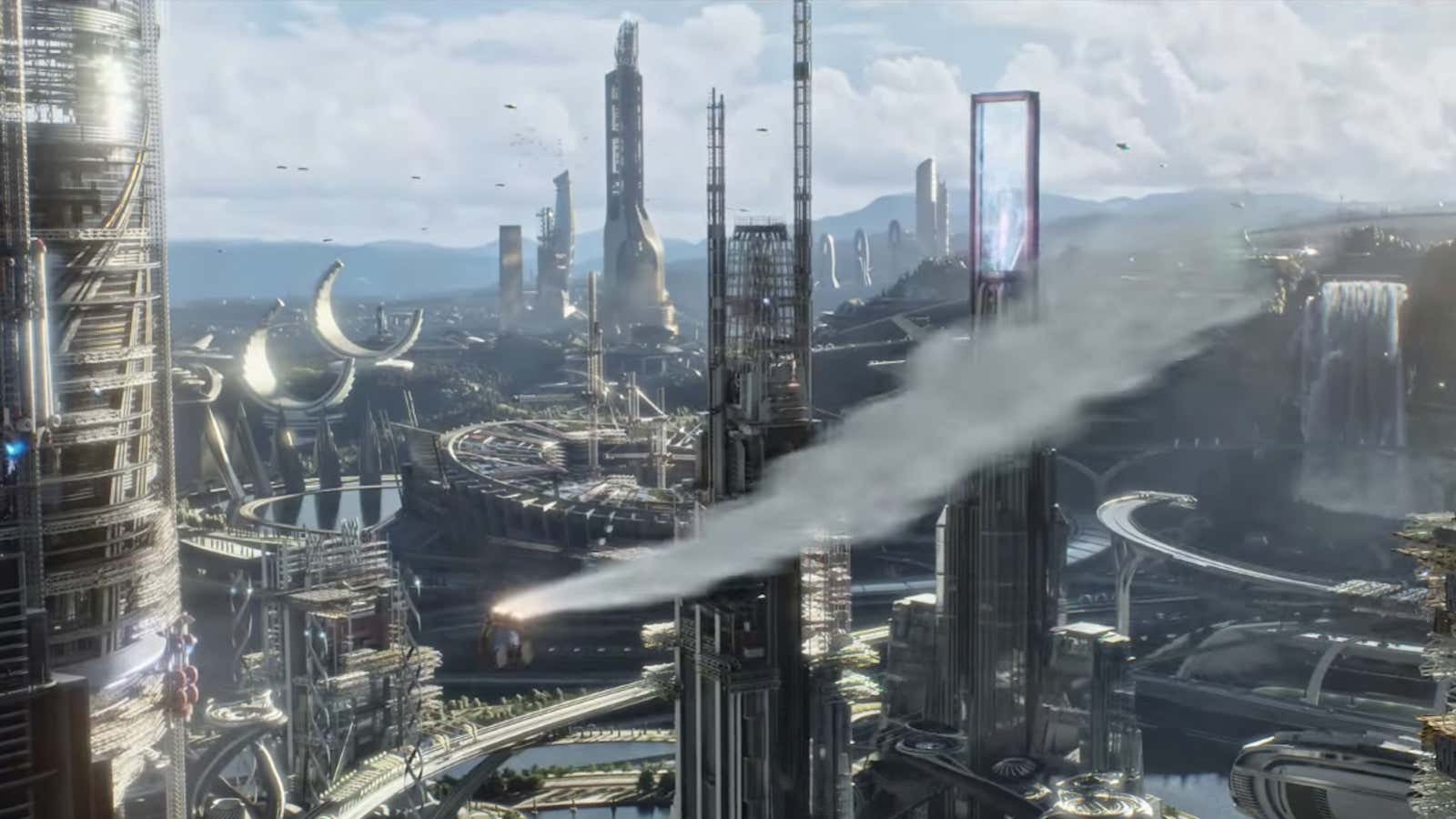How can you make a better future?
It’s a question that’s often asked in big budget Hollywood films, and generally answered with a simple formula—blow up the bad guy.
In superhero films like the Winter Soldier or Age of Ultron, individuals with titanic powers and advanced, miraculous technology use their smarts and godlike abilities to thump robots and demigods—not to, for example, address climate change, or confront systemic injustices. Even a political allegory like Mad Max: Fury Road sees overthrowing the patriarchy in terms of shooting the patriarch and replacing him with a more sympathetic, less male warlord. Action films are built around hitting people, and when all you have is a fist, perhaps it’s not surprising that all problems tend to look like a thumpable supervillain.
Tomorrowland doesn’t exactly alter this tried-and-true formula, but it uses it with revealing, if somewhat incoherent, self-consciousness. The plot is farcically convoluted, but in broad outline, a group of elite geniuses have created an extra-dimensional city from which they can view the future. They realize that the earth is going to destroy itself through a heterogeneous mixture of war and environmental destruction, and it’s up to genius inventor Frank (George Clooney), young genius inventor in embryo Casey (Britt Robertson), and the robot girl Athena (Raffey Cassidy) to prevent catastrophe.
So how does preventing catastrophe work, exactly? The film offers three somewhat contradictory, if familiar, answers. The first is the aforementioned standby: blowing up the bad guys. In this case, said bad guys include a herd of smiling evil robots and Hugh Laurie, who puts in a entertaining turn as a by-the-numbers oleaginous antagonist. There are satisfying explosions and lots of chances to shoot things. Boom. World changed.
Tomorrowland is, to its credit, unusually forthright in acknowledging that shooting a robot is not really a solution to global warming. “Is isn’t hard to knock down a big evil building,” Frank declares. “What is hard is figuring out what to build in its place.”
And here’s where another Hollywood (and Disney) trope comes in: namely optimism. Casey is, naturally, a “Special One” destined to save the earth—and her special superability is hope. The real source of change, the film argues, is not action, but the faith in action. Whenever Casey declares she won’t accept that the world is going to end, the probability that the world will end drops. Vague, generalized assertions that the sun will come out tomorrow literally cause the future to improve by an empirical percentage, measured on the digital output of a convenient visual display. When Casey speaks optimistically, the world is saved—at least by a little bit.
The convenient visual display doesn’t just register future improvements; it is a future improvement itself. That’s because the third way to change the future according to Tomorrowland is through gizmos, or technology. Inventions and new tech are presented as part of a pragmatic solution—Casey is going to “fix the world” because she “understands how things work.” Averting the apocalypse is an engineering problem, different in scale, but not in kind, from fixing kinks in the jetpack.
But tech is also inseparable from enthusiasm and optimism. Casey’s dad is a NASA scientist, and the fact that his project is being defunded is presented as a failure of vision. “It’s hard to have ideas and easy to give up,” Casey muses. To save the world, don’t invest in education or health or welfare, just dump billions of dollars into half-baked space missions so the people falling through your inadequate safety net will be inspired.
It’s not a surprise that Tomorrowland is more interested in rocket ships than in single-payer health care; rocket launches make for more exciting film spectacles. A standard action film is supposed to be about heroes saving the day. Given that, saving the world becomes, inevitably, an individual undertaking. Injustice and scenes of human misery are just superficial hurdles between the good guy and his or her complete self-actualization. Utopia is just like the present, with a couple glitches ironed out.
It’s churlish, perhaps, to expect actual political engagement from genre fare so committed to escapism. And Tomorrowland clearly means well: its ending scenes go beyond blowing up big buildings, presenting a heartfelt plea for dreamers of all kinds to find innovative solutions for a better future.
But, there’s something more than a little numbing in the drumbeat of positivity repeated in multiplex triumph after two-hour triumph. Actual change is slow and difficult and involves compromise and the constant knowledge that, even with the best intentions and the purest heart, you might in fact be making things worse.
Tomorrowland claims to inspire, but you could also see its ostentatious, big-budget platitudes as a form of deliberate mockery. It takes a deep cynicism, after all, to pretend to solve the world’s problems with hope. Hollywood tells its audience to think imaginatively to build a better future while providing them with the same hoary, tired, blandly mendacious narratives as ever. If dreams can change the future, then maybe a first step towards Tomorrowland is finding alternatives to Tomorrowland and its action film heroic status quo.




